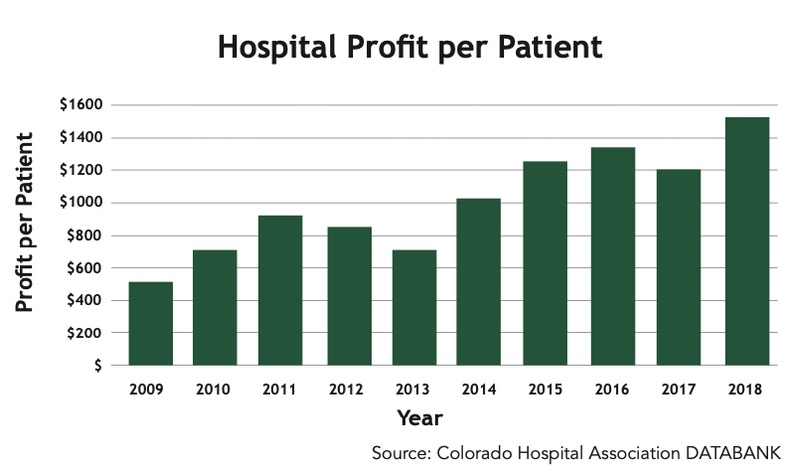Achieving universal access to health care in Colorado is vital and a goal shared by policymakers, hospitals, providers, advocates, insurance carriers, business groups and, most importantly, Coloradans. While Colorado has made significant progress increasing coverage and access, one of the biggest remaining barriers is the high, and increasing, cost of health care. Currently, one in five Coloradans goes without necessary care because of cost, and one in three Coloradans can’t afford their medicine.
Historically, one driver of high costs was that health care providers had to recoup losses from uncompensated care and underpayment by public programs, like Medicaid, by charging other people higher prices. They did that by cost shifting: increasing costs for people who were insured in the private marketplace to cover shortfalls from public payers.
This practice was blamed for raising rates in the private market, which led to the Colorado General Assembly, with the support of hospitals, passing the 2009 Colorado Health Care Affordability Act (CHCAA) to establish the Hospital Provider Fee (later replaced by the 2017 Colorado Healthcare Affordability and Sustainability Enterprise, or CHASE, Act). In addition to Medicaid expansion, Colorado’s adoption of the Patient Protection and Affordable Care Act (ACA) led to increased Medicaid payments to hospitals, a reduction in the number of Colorado’s uninsured, and less bad debt and less charity-care provided by hospitals.
The CHASE Board identified this as an area in need of further research, and in 2018 the Department of Health Care Policy &
Financing (HCPF) analyzed the same dataset and supplemented it with additional research and modeling to help understand the drivers of these increasing costs.
The mechanisms put in place in 2009 to course correct rising health care costs surpassed initial hospital projected savings. Yet since these changes have been implemented, we have not seen cost-shifting decrease. On the contrary, the CHASE Annual Report showed that, despite significant reductions in uncompensated care and significant increases in Medicaid and Medicare rates, hospitals are persistently increasing the price of care.
The CHCAA resulted in a windfall of funding for hospitals, and with the adoption of the ACA of 2010, much more than it was originally anticipated they would receive. The first two legislative mandates associated with the Hospital Provider Fee – reducing the number of uninsured Coloradans and increasing hospital reimbursement – were in HCPF’s purview. After the 2014 Medicaid expansion, half a million additional Coloradans were enrolled in Medicaid and positive patient outcomes continued to grow. While hospitals were responsible for passing savings along to commercial patients, they failed to fulfill that commitment. This is true for both for-profit and non-profit hospitals, especially those located along the front range. Future analysis of individual hospital data will shed light on the differences between urban and rural hospitals.

This so-called need to shift costs to cover payment shortfalls is no longer a plausible or justifiable rationale for price increases. Other states have managed health care costs more judiciously, and their reductions in uncompensated care, as well as other strategic cost-control policies, have resulted in lower costs for everyone, especially employers. They have accomplished this while not just preserving — but expanding — access to quality care. In contrast, health insurance rates in the individual market in Colorado went up by a staggering 80% between 2015 and 2019, and Colorado earned the distinction of having some of the highest hospital prices and profits in the nation.
Colorado is proud to be one of the healthiest states in the country, but despite this achievement, Coloradans face some of the highest health care costs. This report sheds light on the drivers of cost shifting so that policymakers and stakeholders can work together to ensure that all Coloradans have access to affordable health care.
The 87-page report (which you can download here) offers five key findings:
- The cost of health care has gone up much more sharply in Colorado than nationally. These increases are driven primarily by high hospital prices. In fact, on average, Colorado hospitals charge some of the highest prices in the country. In 2009, Colorado hospitals’ operating expenses were 3.2% higher than the national average. By 2018, Colorado hospitals’ operating expenses were 14.0% higher than the national average.
- Hospital profits have increased by more than 280% between 2009 and 2018, from $538 to $1,518 per adjusted discharge. Overall, payment-to-cost ratios (calculated as payment divided by cost; for every dollar in cost, how much is received in payment) across all payers increased from 1.05 to 1.09 between 2009 and 2018 (includes both inpatient and outpatient hospital care).
- Colorado hospitals’ prices went up far more sharply than the growth in patient volume. Colorado hospitals’ prices grew 71.3% between 2009 and 2018 (7.8% per year) while adjusted discharges* only grew 16.6% (1.8% per year).
- Uncompensated care levels in Colorado are at historic lows. The Hospital Provider Fee and the ACA decreased the number of uninsured Coloradans by more than half. As a result, the amount of money hospitals lose annually due to bad debt and charity care has decreased by more than $385 million annually since the Medicaid expansion.
- Cost shifts are driven by strategic hospital decisions, not by shortfalls from public insurance. The increased funding generated by public, taxpayer funded programs — which are intended to reduce private insurance premiums and out-of-pocket costs — are not being passed along to health care consumers and employers. Health First Colorado (Colorado’s Medicaid program) has steadily increased payments year-over-year since 2009. Hospitals could have been passing on significant savings- from the reduction in charity care and the increases in Medicaid payments- to commercial insurance consumers and employers if they had matched national cost benchmarks. Instead, Colorado has far exceeded those cost benchmarks to the disadvantage of consumers and employers.
